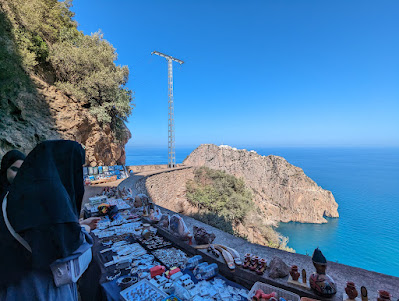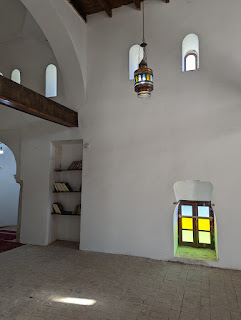Béjaïa is a Mediterranean port city in Algeria about a 3 hour drive east of Algiers. It's also home to some beautiful views from the Gouraya National Park, such as this one overlooking the city.
Relaxing at the seaside hotel Auberge Le Thaïs was the highlight of our long weekend. It's about half an hour away from the city along a windy coastal road. They had a good restaurant overlooking the sea, a pool, and a cool small pebble beach to relax. Who needs a city?
Here's our room overlooking the rocky part of the coast with the sea just below us.
our room was in that building with the pool in the distance
restaurant outside dining
the beach wasn't too crowded on this warm October day
sunset skies on the northern view coast
Gouraya National Park
Gouraya National Park owes its name to the Gouraya Mountain (altitude 660m) located within the park's boundaries. The ground elevation in the park oscillates between -135m and 660m.
Cap Carbon
It's not the hotel of the same name where our escorts took us first because they didn't really know the area. We might need to a hire a guide next time if we come back. There's a cliffside walk through that tunnel and there's monkeys! They're not aggressive and were just chilling on the path walls.
This mountain is a habitat for the endangered primate Barbary macaque. This primate species is the only surviving species in Africa of its genus. Barbary macaques prehistorically had a much wider distribution than at present.
sales tables at the beginning of the walk
On the way back out.
Pic des Singes
Pic des Singes (or Monkey Peak) is a peak northwest of the town of Béjaïa. It is located in the Cap Carbon area of the Tell Atlas range. Ironically, we didn't see a single monkey here. They were all down at place marked Cap Carbon on the map, which was well below here down a winding mountain road.
the port city of Béjaïa
We spent the first part of the day at the national park and the afternoon in the city. The city probably would have been better with a guide to tell us more about the history and direct us to some interesting places. We had a short visit and stumbled around with our escorts who ended up not being from this area, so they weren't much help in finding the highlights.
Wikipedia reveals that the Casbah of Béjaïa is a medieval-era government citadel. It was built by the Almohads in the middle of the 12th century (around 1154), then remodeled by the Spanish during the capture of the city in 1510. It was then modified by the Ottomans and the French.
The Casbah was closed for renovations, but they let us and some select other people visit a few of the buildings. The kind person overseeing it told us a variety of facts including a proud discussion of Fibonacci. It's interesting, so I've gone down the Wikipedia rabbit hole and reproduced some of it here for that one other person who might read it (my wonderful wife).
The Casbah of Béjaïa played a role in the transmission of knowledge in the Middle Ages, through the long stays of scientific and literary personalities, versed in all areas of knowledge. One particularly notable person was the Italian mathematician Leonardo Fibonacci.
Born in Pisa, a maritime republic, his education was largely in Bugia (now Béjaïa) in the central Maghreb (present-day Algeria), where his father was a merchant and customs notary public on behalf of the order of merchants of the republic from Pisa. At this time, Béjaïa was not only an important commercial port but also a major intellectual center. Fibonacci began his education in mathematics there.
Fibonacci is better known today for one of his problems leading to the numbers and sequence bearing his name. He posed and solved a problem involving the growth of a population of rabbits based on idealized assumptions. The solution, generation by generation, was a sequence of numbers later known as the Fibonacci numbers.
A mathematical-historical analysis of Fibonacci's context and proximity to Béjaïa, an important exporter of wax in his time, has suggested that it was actually the bee-keepers of Béjaïa and the knowledge of the bee ancestries that truly inspired the Fibonacci sequence rather than the rabbit reproduction model as presented in his famous book Liber Abaci.
Although Fibonacci's Liber Abaci contains the earliest known description of the sequence outside of India, the sequence had been described by Indian mathematicians as early as the sixth century.
Fibonacci travelled around the Mediterranean coast, meeting with many merchants and learning about their systems of doing arithmetic. He soon realized the many advantages of the Hindu-Arabic system. In the Liber Abaci (1202), Fibonacci introduced the so-called modus Indorum (method of the Indians), today known as the Hindu–Arabic numeral system, with ten digits including a zero and positional notation. The book showed the practical use and value of this by applying the numerals to commercial bookkeeping, converting weights and measures, calculation of interest, money-changing, and other applications.
Liber Abaci was well-received throughout educated Europe and had a profound impact on European thought. Replacing Roman numerals, its ancient Egyptian multiplication method, and using an abacus for calculations, was an advance in making business calculations easier and faster, which assisted the growth of banking and accounting in Europe.
This illustrates the links between the commercial dynamism of Italian cities in the 12th-13th centuries and scientific progress around the Mediterranean. Residing in Pisa from 1198 to 1228, he compiled his mathematical knowledge in his various works.
It all spread to Europe from here in Béjaïa!
This mosque building was also the library of the citadel with a still functional well.
Back to the hotel to relax. No words needed.
sunrise
A final morning at the beach before heading back. It was an American holiday for us, so nobody was at the beach with us until a little later when a few people showed up.
Grapes for sale by the road on the way home.























































































No comments:
Post a Comment